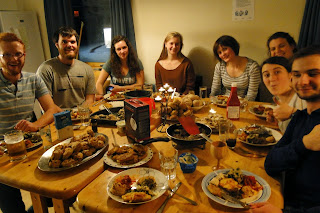The last couple of days have - once more - been an amazing time. One would (and I did) believe that the darkness is going to be a tough one and that it will be depressing and extremely sleepy all the time. Of course, we are all looking forward to see the sun again (actually it is mentioned in every single conversation at least once), but the time here has been great, unfailingly! Every single day, something extraordinary was going on. And it might just have been extraordinary because we are in the Arctic and it is dark 24/7.
Today we got a lift back to our barracks and the car got stuck in deep snow so that we spent more than an hour to dig it out and in the end we needed another car to drag it along.
Figure 1: After one hour and a big hole in the ground later: The van is out of the snow
Yesterday, we experienced a power outage. The whole town was out of electricity for about 20 minutes. All the people that are still in Nybyen gathered on the road waiting for the electricity to come back and discussing the worst scenario and horror films (e.g. "30 days of night" started somehow just like that). Great fun! After that we went to the Santa Claus mine which, by now, is illuminated because - as we all know - Santa is really busy this month. We took some mulled wine and cookies with us and were just enjoying the last days. However, we couldn't find Santa.
Our way back was ridiculously fast: We used butt sledges and were at the bottom in less than 10 minutes while our way up took at least an hour. After that we spent the night in the hot tub one last time.
Figure 2: Hot tubing and northern lights. (credits: Ole Divino Randmæl)
Figure 3: The last bunch of people in Nybyen before christmas (credits: Luci Marshall)
Figure 4: Santa Claus Mine in december
On sunday, we finally went hiking after weeks of revision. It was my first hike in the total darkness. We went up the plateau on the western side to get the full darkness-moon-stars-and-northern-lights-experience which worked fine: We've had a golden moon shining on us while the northern lights were dancing next to it. AMAZING! The way uphill was hard work though due to snow drifts that let us sink in deeply so that we ended up crawling up on all fours. Luci could take some great pictures from both the hike and the santa claus mine night.
Figure 5: Crawling uphill
Figure 6: Night hike with a golden moon shining! (credits: Lucianne Marshall)
Figure 7: oh yeah, northern lights as well (credits: Luci again :) )
The last couple of days were filled with good byes. That's the only really bad thing about Svalbard: We've met people from literally all over the world. We will see some of them next semester, but we had to say "Goodbye and enjoy the rest of your life" to most of our friends which is making the last couple of days also quite sad. As Allan mentioned in his last blog entry: friendships are developing extremely fast and close up here because we are all sharing the same adventures and problems.
The northern lights have been very active the last week so that we've spent a great amount of time outside. Also, a friend discovered fresh Polar Bear tracks when being out for field work no more than 3.5km from Longyearbyen followed by two more tracks from different polar bears discovered in the next days all pretty close to Longyearbyen. A couple of weeks ago, two fellow students had to be rescued from Sysselmannen after being out for a hike where they sighted two bodies in the distance which were just too big for being reindeers only. So also the frightening feeling of having these animals around when being out for a hike makes it even more exciting.
Figure 8: Huge, fresh polar bear tracks in Endalen (discovered and photographed by: Michael Lawrence)
I am very excited for next semester. New people, new challenges, new modules AND 24 hours daylight. I wonder if that will play with our food and sleeping patterns as much as the darkness.
For now, I can summarise that I love Svalbard for being extreme in all directions: Latitude, daylight/darkness, wildlife, snow and ice, adventures and - most important - the incredible bunch of people up here!
One of my barrack mates made this beautiful time lapse video of the Polar night. All time lapses are taken right from around the barrack I am living in:
https://www.youtube.com/watch?v=ETSi7QGz598
See you next semester!






















































